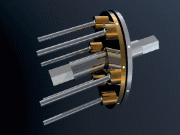
Human Friendly Transmission
Encyclopedia

Continuously variable transmission
A continuously variable transmission is a transmission that can change steplessly through an infinite number of effective gear ratios between maximum and minimum values. This contrasts with other mechanical transmissions that offer a fixed number of gear ratios...
made by Honda
Honda
is a Japanese public multinational corporation primarily known as a manufacturer of automobiles and motorcycles.Honda has been the world's largest motorcycle manufacturer since 1959, as well as the world's largest manufacturer of internal combustion engines measured by volume, producing more than...
for some of its motorcycles. It has been used on the Honda DN-01
Honda DN-01
-External links:* official page* in Popular Science...
and on the EVO6 concept motorcycle.
The electronically controlled
Powertrain Control Module
A Powertrain Control Module, abbreviated PCM, is an automotive component, an electronic control unit , used on motor vehicles. It is generally a combined control unit, consisting of the engine control unit and the transmission control unit. It commonly controls more than 5 factors in the car or...
automatic transmission system is unlike more familiar belt-driven CVT systems used on scooter
Scooter (motorcycle)
A scooter is a motorcycle with step-through frame and a platform for the operator's feet. Elements of scooter design have been present in some of the earliest motorcycles, and motorcycles identifiable as scooters have been made from 1914 or earlier...
s, nor does it have a torque converter
Torque converter
In modern usage, a torque converter is generally a type of hydrodynamic fluid coupling that is used to transfer rotating power from a prime mover, such as an internal combustion engine or electric motor, to a rotating driven load...
, typical of automotive applications. Instead it is a hydrostatic drive that employs a variable displacement
Variable displacement pump
A variable displacement pump is a device that converts mechanical energy to hydraulic energy. The displacement, or amount of fluid pumped per revolution of the pump's input shaft can be varied while the pump is running....
axial piston pump
Axial piston pump
An axial piston pump is a positive displacement pump that has a number of pistons in a circular array within a cylinder block. It can be used as a stand-alone pump, a hydraulic motor or an automotive air conditioning compressor.-Description:...
with a variable-angle swashplate
Swashplate
A swashplate is a device used in mechanical engineering to translate the motion of a rotating shaft into reciprocating motion, or to translate a reciprocating motion into a rotating one to replace the crankshaft in engine designs.- Construction :...
. Apart from Honda, this type of system has not been seen in road-going consumer motor vehicles, though it is familiar in industrial applications and heavy equipment such as forklifts and the US Air Force's MJ-1 bomb lift truck, in use since the 1950s. Honda has also dabbled in this technology since the 1950s. It appeared on their 2001 FourTrax Rubicon 4-wheel, off-road ATV
All-terrain vehicle
An all-terrain vehicle , also known as a quad, quad bike, three wheeler, or four wheeler, is defined by the American National Standards Institute as a vehicle that travels on low pressure tires, with a seat that is straddled by the operator, along with handlebars for steering control...
.
The electronic controls allow the motorcycle to be operated in three modes: Drive, Sport and Manual. In Drive and Sport, it functions much like a CVT scooter, with infinitely variable gearing upshifted and downshfited automatically for what the system determines to be optimal performance. Unlike a scooter, engine braking is always available when decelerating. The difference between Drive and Sport modes is that Drive is optimized for economy while Sport is more responsive. In Manual mode, the transmission operates in one of six discrete gears chosen by the rider by pushing a plus/minus button on the left handlebar. It feels much like a normal motorcycle, including hitting the rev limiter at the top of each gear, but the ECU prevents upshifting and downshifting too soon. In all modes, it automatically returns to the lowest gear when stopped. It is also possible to switch into neutral while stopped, unlike a scooter.
External links
- Motorcycle Picture Book | HFT (Human-Friendly Transmission) Honda's animated visualizations of HFT operation (Adobe Flash).

